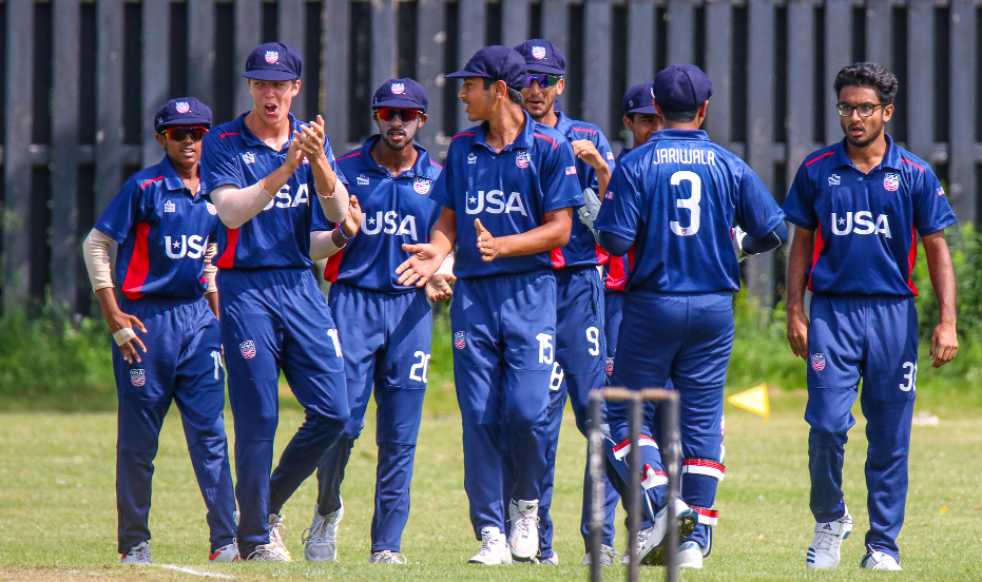While the United States is asleep in the early hours of Sunday morning, India will be gearing up for its most significant sporting event in over a decade.
In the Cricket World Cup final, India will face Australia in front of a sell-out crowd of 132,000 at the Narendra Modi Stadium in Ahmedabad, the largest sports ground on the planet. It will bring the world’s most populous country (1.4 billion and counting) to a standstill.
The tournament may not have attracted America’s attention, but that may be about to change. Another World Cup final is coming next year, this time in cricket’s shortest international format of Twenty20 (T20) — a version that typically lasts around three hours and gives each side 20 overs (made up of six balls). And for the first time, it is being played in the U.S.
Cricket’s rules may be complicated, and its formats confusing, but it is also increasingly big business. The 2019 50-over World Cup tie between Pakistan and India surpassed the Super Bowl and the NBA Finals as one of the most-watched sporting events of that year, reaching a global cumulative audience of 323 million viewers across television and digital platforms.
Its players, too, are now global superstars. He does not often make SportsCenter’s Top 10, but India star Virat Kohli (pictured above) is Instagram’s third-most followed athlete (262 million) — more than LeBron James, Tom Brady and David Beckham combined.
Kohli is the face of a new era of a sport desperate to appeal to new audiences. Since the introduction of the T20 format in England two decades ago, cricket has become more fast-paced, and the stadiums are attracting louder, younger crowds. Now there is a plan to wrestle a piece of the cricketing pie from established powers like England, India, Pakistan, South Africa, Australia and the West Indies.
In 2024, around a third of the 55 matches of the T20 Cricket World Cup will take place on American soil, with the rest in the West Indies. It follows the success of Major League Cricket’s first season, which ran through July of this year, bringing some of the world’s best and most recognisable cricketers stateside. Four years later, Los Angeles is bringing cricket to the 2028 Olympics for the first time since 1900.
Major League Cricket currently has six teams — Los Angeles Knight Riders, San Francisco Unicorns, Seattle Orcas, Texas Super Kings, Washington Freedom and inaugural champions MI New York — and is owned by American Cricket Enterprises (ACE), which pledged an investment of $1billion to USA Cricket, the country’s governing body for the sport, in 2019 to win the rights to create the league.
It is not the first time America has given cricket a crack, though. Since the turn of the century, there have been several attempts to launch a professional cricket league in a country where a wooden bat is more likely to be round than flat. Pro Cricket survived one season before folding in 2004, while the original Major League Cricket announced plans to launch in 2005 and soon suffered a similar fate. Shane Warne and Sachin Tendulkar — two of the greatest cricketers of all time — hosted a series of exhibition matches across the U.S. in 2015 but failed to take the interest mainstream.
This time, however, backed by several Indian-American tycoons and franchises from the Indian Premier League, the game’s most powerful and lucrative franchise competition, Major League Cricket demonstrated the potential of one of the world’s biggest sports in the globe’s biggest marketplace.
“It was an incredible proof of concept that domestic American cricket can work and has a real, dedicated fan base,” Tom Dunmore, vice president of marketing for Major League Cricket, told The Athletic. “We sold more than 90 per cent of our tickets. Most of the games in the evening were sold out, but more than the number, it was the passion on display. The flags waving, the fans cheering — fans were seeing heroes they are used to watching on television from thousands of miles away, right in front of their eyes.”
Despite sweltering conditions, which saw temperatures cross 100 degrees Fahrenheit (38 degrees Celsius), cricket-literate crowds sold out 11 of the 19 matches. Twelve of those were played at the 7,200-capacity Grand Prairie Stadium near Dallas, Texas — an area of the United States with a significant South Asian population. Grand Prairie, which began its life as a baseball venue in 2008 before then hosting professional soccer matches, received a $20 million redevelopment to convert it to a cricket ground in 2022.
The rest were at Church Street Park in Morrisville, North Carolina, a smaller cricket-specific ground set to undergo improvements in preparation to host international fixtures, meaning five of the six Major League Cricket teams are yet to play in their home market.
With a willingness from investors to continue spending despite projecting financial losses in its early years, Major League Cricket is already one of the wealthiest cricket leagues in the world. It has attached itself to the Indian Premier League, club cricket’s most popular league, through a partnership with four teams: the Kolkata Knight Riders, Chennai Super Kings, Delhi Capitals and the Mumbai Indians, the IPL’s top franchise at a valuation of $1.3 billion (£1bn), according to Forbes.
Flush with cash and affiliated with the sport’s most powerful brands, Major League Cricket attracted some of the sport’s biggest names and stars before this year’s World Cup. The league’s leading wicket-taker in its inaugural season was New Zealand’s Trent Boult, considered among the best fast bowlers of his generation and a key member of the side that reached the semi-finals in India.
Quinton de Kock and Kagiso Rabada have been representing South Africa at the current World Cup, and Aaron Finch and Kieron Pollard, former captains of Australia and the West Indies, respectively, stand out among a star-studded list of internationals.
Jason Roy gave up an international contract with England to sign a deal worth a reported $372,000 (£300,000) over two seasons with the Los Angeles Knight Riders, who share ownership with the Kolkata franchise Roy played for in the IPL this year. While Roy’s deal is significant for an emerging league, it does not yet compete with the IPL, where the highest-earning players make around $2million for less than two months of play.
“It’s very appealing for the players to come here,” says Dunmore. “We quickly showed that it would be competitive and that we’re going to be a top-three league in the world very quickly. In terms of play, interest in the league, and the conditions we’re providing the players, we’re first-class. The players have come over here and had a tremendous experience.
“We’re competitive financially with every league in the world outside the IPL, which nobody competes with, so we can offer a really good package for international players. We also compete in the Northern Hemisphere summer, and the majority of our competition competes in the Southern Hemisphere summer — allowing the players to play with us in the summer and elsewhere in our winter and spring.”
For those watching from further afield, there was little to distinguish the production value from some of its more established competitors. CBS Sports Network was the lead broadcaster alongside cricket-specific broadcaster Willow TV for U.S. audiences, and matches were streamed live in various other countries. The broadcasts were professional and modern and featured Sunil Gavaskar, a legend of Indian cricket, and former South Africa captain Graeme Smith, among other recognisable names on commentary.
The difference in quality on the field was more noticeable, with the international stars levels above some of their American team-mates, who make up around half of the league. It is a steep learning curve which league stakeholders view as crucial for the development of domestic cricket.
“When I came to Seattle in 1989, there weren’t any cricket teams,” Soma Somasegar, co-owner of the Seattle Orcas, told The Athletic. “Today, there are about 250 to 300 cricket teams in Seattle spread across multiple leagues. That grassroots energy and excitement is true, not just in Seattle but in a lot of cities in the country. So, before building this league, we set up between 30 and 40 cricket academies in the United States, as well as a minor league in 2021. Now, 26 cities in the U.S. have a minor league team competing for the minor league championship every year.
“We’re trying to think for the long term. Attracting the stars is part of how we start; using what they do to penetrate school and college environments to help people see cricket is interesting. Our dream is that kids can see that and then grow up here to play at college or professionally.”
As the development program improves, the United States is slowly becoming more of a player on the international stage. In December 2021, the United States defeated Ireland in a T20 match. The win was due in part to a high-scoring batting partnership between Indian-born Sushant Modani and Gajanand Singh, born in Guyana, a Caribbean country on the northern coast of South America. It was their first international victory against a nation that also competes in Test cricket, the game’s longest and most historic form, which can last up to five days.
Next year, they will have the chance to record their first victory in the T20 World Cup, qualifying for the tournament for the first time as hosts. From amateur cricket to a top-three international league, a World Cup and an Olympics debut within five years — it is an ambitious plan for a sport that does not register in the mind of the average American sports fan.
The lack of infrastructure has prevented the international and league products from reaching audiences outside areas with cricket-specific stadiums, so next year’s tournament will serve as a litmus test to see crowd reactions in New York, Florida and the Dallas area, where the baking mid-summer heat could deter new audiences. Still, Major League Cricket and its investors are determined to realise their long-term vision.
“It takes time,” says Dunmore. “We’re working really hard to see if it is possible to expand the number of venues by next summer, and if not, then we expect a majority of our teams to have home venues by 2026, which would still be a really fast process. Next year, though, is massive for us to build a legacy with the sport and break out of the main cricket fan base — we saw that with soccer here for the men in 1994 and the women in 1999. It took soccer outside the ethnic fanbase here and helped it to grow.
“Cricket can also experience a bit of that with the World Cup. We’re really excited to see where that can take the sport.”

 119 Views
119 Views 0 comments
0 comments

Comments